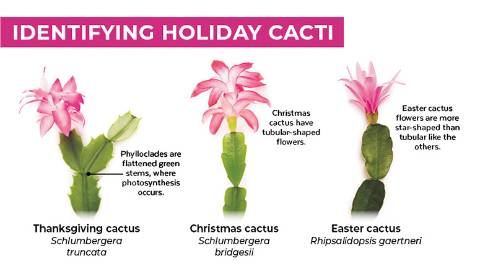What Holiday Cacti do I have?

Thanksgiving cactus (Schlumbergera truncata), Christmas cactus (Schlumbergera bridgesii), and Easter cactus (Schlumbergera gaertneri) are popular houseplants, often given as gifts during the holiday season. They are grown for their beautiful, exotic flowers. These three cacti are found in the high-altitude, tropical rainforests of South America where they grow on trees and rocks. These three plants are often mistaken for one another, in part because greenhouses often mislabel them. Let's start from the left. The Thanksgiving cactus is the most commonly sold holiday cactus in the United States. They are sold under the name "Christmas cactus" however, they are two different species. Thanksgiving cacti have hooks or points on the stem (I think of them as the spurs on a turkey) that distinguish them from the other two types of holiday cacti. This holiday cactus is the most common because the flowers come in a wide range of colors, it is easier to get them to bloom and finally, their growth habit makes it easier to ship them. In the middle is the true old-fashioned Christmas cactus. This cactus variety has scalloped edges rather than points and typically blooms from early December to January. Christmas cactus have fewer bloom colors and tend to have a drooping growth habit rather than the upright habit of a Thanksgiving cactus. The Easter cactus is the last one and, until recently, was the least common. This cactus has stem edges that are scalloped, much like the Christmas cactus, but the blooms are star-shaped rather than tubular.
No matter which holiday cacti you have the care is very similar. All of these cacti prefer bright, indirect light. Too much sun can result in the leaves turning yellow. These plants are native to a damp, tropical location and require more water than a traditional cactus. Lightly fertilize the plants every other week after they quit blooming in the spring till mid-fall. Unlike many cacti, holiday cacti are heavier feeders and need more nutrients. Blooming will normally cease in late winter to early spring.

Have questions? Contact our office where our Horticulture Extension Agent will assist you with questions.
Phone: (316) 321-9660
Email: callae@ksu.edu